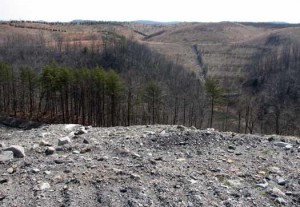- Like
- Digg
- Del
- Tumblr
- VKontakte
- Buffer
- Love This
- Odnoklassniki
- Meneame
- Blogger
- Amazon
- Yahoo Mail
- Gmail
- AOL
- Newsvine
- HackerNews
- Evernote
- MySpace
- Mail.ru
- Viadeo
- Line
- Comments
- Yummly
- SMS
- Viber
- Telegram
- Subscribe
- Skype
- Facebook Messenger
- Kakao
- LiveJournal
- Yammer
- Edgar
- Fintel
- Mix
- Instapaper
- Copy Link
Contact:
Sean Sarah, Sierra Club, 330 338-3740, sean.sarah@sierraclub.org
Dianne Bady, Ohio Valley Environmental Coalition, 304 522-0246, dbady.ovec@gmail.com
Cindy Rank, West Virginia Highlands Conservancy, 304 924-5802, clrank2@gmail.com
Coalition Seeks To Hold Landowner Responsible for Mining Pollution
Shuttered Mountaintop Removal Mines Still Polluting West Virginia Rivers and Streams
Charleston, WV – Environmental groups including Ohio Valley Environmental Coalition, West Virginia Highlands Conservancy and Sierra Club – represented by Appalachian Mountain Advocates attorneys Amy Vernon-Jones and Joe Lovett – initiated legal action today to stop pollution from three valley fills at the site of the now “reclaimed” White Flame mountaintop removal mine. Today’s action,, filed in the U.S. District Court for the Southern District of West Virginia, argues that landowning companies are responsible for ensuring that former mountaintop removal sites still meet Clean Water Act protections against mining pollution. In the case of the Pocahontas Land Corporation owned White Flame mine, water testing downstream from the site has found that valley fills are responsible for high levels of selenium and ionic pollution, and therefore the corporation has failed to meet its legal responsibility to mitigate pollution entering local waterways.
“Just because the mining has stopped doesn’t mean the pollution has come to an end,” said Liz Wiles, Chair of the West Virginia Sierra Club. “Corporate owners of so called ‘reclaimed’ mining sites, like Pocahontas, must take responsibility for their land and their pollution. Sierra Club and its allies will continue to work to ensure that Appalachian rivers and streams are protected and that mine operators and land owners are held responsible for cleaning up the pollution they created.”
Even after a mine is reclaimed, valley fills continue to collect and channel water into local waterways. Valley fills are engineered with ditches on their surface and drains underneath; these ditches and drains are integral to the permanent structural stability of the fills, and so are not removed when a mine is reclaimed. Water samples collected by independent sources and the West Virginia Department of Environmental Protection downstream from the White Flame Mine valley fills found increased ionic pollution and selenium levels in the stream. Elevated levels of those pollutants are reliable indicators of continuing pollution coming from valley fills linked to active and reclaimed surface coal mines.
“The legacy of polluted streams from coal mining cannot go unaddressed unless we want to leave the burden of living with damaged water to our children and grandchildren and to any new industries that want to invest in the state,” said Cindy Rank of the West Virginia Highlands Conservancy. “We can and must do better, including making sure that the corporate owners of these mined lands bear the responsibility and costs of treating the pollution that continues to flow from their properties.”









Thanks to these groups and individuals who continue to take our leaders and these companies to task in the destruction of our state and the world at large.